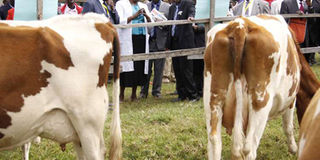Study: Many cows affected by mastitis in Nyeri County

Dairy cattle on show during an exhibition at the Eldoret National Polytechnic Annual International Conference on Innovation for Advancement of Humanity. PHOTO | JARED NYATAYA | NATION MEDIA GROUP
What you need to know:
- Research study shows that mastitis has led to decline in milk production in Nyeri county.
- Mastitis is a bacterial disease that inflames and gradually scars the udder tissue of dairy cows, altering its composition.
- Cleaning teats before milking greatly reduce spread of toxins that cause injury to tissues and udder ducts.
- Ensure teat ends are cleaned and any objects on them removed because milking equipment needs a dry treat for better suction, while in manual milking it prevents transfer of bacteria through water.
A study conducted in Nyeri shows that mastitis is prevalent in the county and has led to a decline in milk production.
According to Mbae Nkoroi, assistant director, regional veterinary investigative laboratory, the bacterial disease affects cows without the farmers’ knowledge.
In response, the county government has procured additional five laboratory machines worth over Sh4 million to help mitigate the rising cases of the bacterial disease.
Dr Nkoroi says the machines will help detect the percentage of bacteria in the animals.
“Poor hygiene and milking techniques are the major causes of the disease,” he said, adding the cold weather affects milk production.
Mastitis is a bacterial disease that inflames and gradually scars the udder tissue of dairy cows, altering its composition.
Usually, it occurs when the udders becomes inflamed because leukocytes, or somatic cells, are released into the mammary gland in response to invasion of the teat canal, usually by the bacteria.
These bacteria multiply and produce toxins that cause injury to milk-secreting tissues and various ducts throughout the mammary gland.
More than 100 different micro-organisms can cause mastitis, yet the route by which they reach the cow varies greatly.
According to Dr Nkoroi, the main hindrance to eradicating the disease is that farmers are unaware of measures to control the disease because of inadequate extension officers in the county.
MEASURES TO BE TAKEN
When the udders of cows become infected, a host of expenses and losses occur. For example, animals sometimes must be culled and potential superior genetics are lost.
Profitability is reduced through treatment and reproductive performance can be reduced.
While there is no simple solution to prevent the disease here are some measures farmers can use to ensure their animals are mastitis-free.
- For optimal milk production create a clean, stress-free environment. The hormone oxytocin is best stimulated under a stress-free environment which starts with a clean stall and parlour.
- Cleaning teats before attaching the milking machine or manually milking the cows is a significant step in preventing bacteria from from getting into the teat canal during the milking process.
- Examine the udder by looking for chapped, cracked and bleeding teats. Also, examine and score teat ends. You should not milk chapped, cracked or bleeding teats or teat ends. These teats are susceptible to new IMIs (intra-mammary infections).
- Ensure you use paper towels or reusable cloth towels to clean and dry teats. One paper or cloth towel should be used for each cow to wipe the teats clean before the milking process starts.
You have to make sure teat ends are cleaned and any objects on them removed because milking equipment needs a dry treat for better suction, while in manual milking it prevents transfer of bacteria through water.
Dr Nkori said that early detection of the bacterial disease will help farmers treat cows better as well as reduce transmission to other cows in the daily operation.





